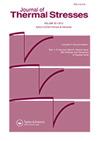焦耳加热和椭圆腔引起的温度相关热弹性问题的解析解
IF 2.6
3区 工程技术
Q2 MECHANICS
引用次数: 0
摘要
摘要电流引起的焦耳热很容易引起热应力,从而导致现代材料的结构破坏和裂纹演化。本文采用复变方法计算了在远端电载荷和热载荷作用下平板椭圆腔周围的热弹性场。特别有趣的是,我们考虑了相应热弹性系数的温度依赖性。本文介绍了一种分析方法,当热弹性系数与温度无关时,其结果与文献中的经典分析结果一致。我们发现,当椭圆空腔被简化为线性裂纹的表示时,在温度相关假设下,相应的应力强度因子比相应的经典结果增加得更大。我们的发现对于分析裂纹在焦耳热载荷等严重温度梯度下的扩展演化具有重要意义。关键词:裂纹阻滞电流焦耳热应力强度因子温度相关热弹性场披露声明作者未报告潜在的利益冲突。作者感谢国家自然科学基金委员会(NSFC)(11872203)和中国国家留学基金委(CSC)的支持。航空航天先进制造技术研究联合基金(U1937601)和国家自然科学基金(51921003)资助。Schiavone感谢加拿大自然科学与工程研究委员会(批准号:RGPIN - 2017 - 03716115112)。本文章由计算机程序翻译,如有差异,请以英文原文为准。
Analytical solution of the temperature-dependent thermoelastic problem induced by Joule heating and the presence of an elliptic cavity
AbstractJoule heat induced by electric current may well lead to thermal stress and contribute to structural failure and crack evolution in a range of modern materials. In this paper, we use complex variable methods to obtain the thermoelastic fields around an elliptic cavity in a plate subjected to remote electric and thermal loads. Of particular interest is the fact that we consider the temperature dependency of the corresponding thermoelastic coefficients. We introduce an analytical method which is verified by the fact that it leads to results which reduce to the classical analytical results in the literature when the thermoelastic coefficients are taken to be temperature-independent. We find that when the elliptic cavity is reduced to the representation of a linear crack, the corresponding stress intensity factor increases to a greater extent under the temperature-dependent assumption versus the corresponding classical results. Our findings are significant in forming the basis for the analysis of the evolution of crack growth under severe temperature gradients such as those occurring as a result of Joule heat loading.Keywords: Crack arrestelectric currentJoule heatstress intensity factorstemperature-dependentthermoelastic fields Disclosure statementNo potential conflict of interest was reported by the author(s).Additional informationFundingThe authors would like to thank support from the National Natural Science Foundation of China (NSFC) (11872203) and China Scholarship Council (CSC). This work is also supported by the Joint Fund of Advanced Aerospace Manufacturing Technology Research (U1937601) and the National Natural Science Foundation of China for Creative Research Groups (No. 51921003). Schiavone thanks the Natural Sciences and Engineering Research Council of Canada (Grant No: RGPIN – 2017 - 03716115112).
求助全文
通过发布文献求助,成功后即可免费获取论文全文。
去求助
来源期刊

Journal of Thermal Stresses
工程技术-力学
CiteScore
5.20
自引率
7.10%
发文量
58
审稿时长
3 months
期刊介绍:
The first international journal devoted exclusively to the subject, Journal of Thermal Stresses publishes refereed articles on the theoretical and industrial applications of thermal stresses. Intended as a forum for those engaged in analytic as well as experimental research, this monthly journal includes papers on mathematical and practical applications. Emphasis is placed on new developments in thermoelasticity, thermoplasticity, and theory and applications of thermal stresses. Papers on experimental methods and on numerical methods, including finite element methods, are also published.
 求助内容:
求助内容: 应助结果提醒方式:
应助结果提醒方式:


